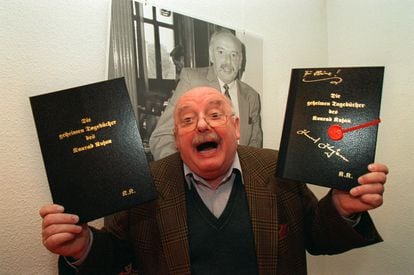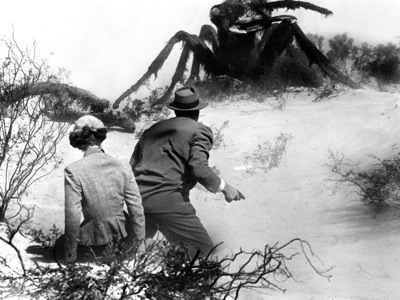Alex Constantine - March 23, 2023
Four decades after the biggest fake news scandal in history, the full contents of the forged tomes, which paint the Führer as a sympathetic statesman ignorant of the Holocaust, have been made public
/cloudfront-eu-central-1.images.arcpublishing.com/prisa/633FCJCGSRHTDPHBAZFURZDTTY.jpg) 'Stern' journalist Gerd Heidemann holds two of Hitler's supposed diaries during a press conference on April 25, 1983. WOL FGANG WIESE (GETTY)
'Stern' journalist Gerd Heidemann holds two of Hitler's supposed diaries during a press conference on April 25, 1983. WOL FGANG WIESE (GETTY)
-On April 25, 1983, Stern summoned the world’s media to a press conference to announce a truly extraordinary find: the West German magazine’s star reporter had uncovered Adolf Hitler’s personal diaries and was preparing to publish their contents. The diaries consisted of dozens of volumes, which had supposedly been lost in a plane crash at the end of April 1945 but which, nearly 40 years after the fall of the Third Reich and Hitler’s suicide, someone had suddenly decided to bring to light. The sensational exclusive caused shockwaves around the world. Photographs of the Stern journalist, Gerd Heidemann, holding the notebooks penned by the Nazi dictator aloft were published in news outlets in every corner of the globe.
Even then, the images of Heidemann with the incredible discovery in hand may have inspired some suspicion. The initials engraved on the cover of the notebooks were not AH, but FH, because, as it transpired later, the forger who produced them had confused the two Gothic letters. Stern published only two installments: it took just two weeks to prove that the diaries were fakes. They had been written by a forger and petty criminal named Konrad Kujau, who frequented neo-Nazi circles. The scandal almost destroyed the magazine, which had been founded in 1948 in Hamburg and once had a readership of 1.8 million.
One of the greatest journalistic frauds of the 20th century is back in the news, 40 years after the first issue of the series in Stern, which proclaimed in huge red letters: “Hitler’s diaries discovered.” Hamburg-based public broadcaster NDR has now digitized the notebooks and published them in full, providing a search engine that allows people to consult day by day and by keyword what the Nazi dictator supposedly recorded. Curiously, there is no trace of the words Auschwitz or Holocaust. The texts have been contextualized with the help of historians and political scientists, who have concluded that the greatest “scoop” of the 20th century was not only a story of greed and prestige, but also of obscure political and revisionist interes
One of Hitler's fake diaries displayed at 'Stern' magazine's headquarters in Hamburg in 2018 on Journalism Day.PICTURE ALLIANCE (PICTURE ALLIANCE VIA GETTY IMAGE)“The diaries are the closest anyone has come to rehabilitating the figure of Adolf Hitler,” says John Goetz, the NDR investigative journalist who led the project. “Historians hadn’t been able to understand what was in there. Nobody had been able to read the diaries,” says during a telephone conversation with EL PAÍS. Until now, only a few verbatim quotations had been available because Stern and other media to which the rights were sold, such as UK newspaper The Times, halted publication and the originals never left the safe of the Gruner + Jahr publishing house in Hamburg. Goetz was able to recover the content of the diaries through copies preserved in the court docket of the case and has now published The Real Fake Hitler Diaries, a 672-page edition annotated by historians Heike B. Görtemaker and Hajo Funke.
The fake diaries, which mixed intimate reflections with political slogans and current events, depict a strangely peace-loving and statesmanlike Hitler who was unaware of what was happening to the Jews. After NDR’s analysis, the phrase with which Stern publicized its discovery – “The history of the Third Reich will have to be rewritten to a large extent” – takes on new meaning. The authors of the forgery wanted readers to believe that Hitler was unaware of the Holocaust. “It is a key moment of Holocaust revisionism in German history that has been misunderstood until now,” notes Goetz.
On July 31, 1941, when the genocide was already underway, the diaries contain an entry in which Hitler writes that the Jews must be persuaded to emigrate quickly or “seek a safe haven in the occupied territories where they can feed and fend for themselves.” The entry for January 20, 1942, the day of the Wannsee Conference that organized the deportation of all European Jews to extermination camps, the so-called “final solution,” is hair-raising: “I await the reports of the conference on the Jewish question. We must find a place in the East where these Jews can stay,” it reads.
Beyond alleged ignorance of the Holocaust, the fake Hitler is also opposed to racial laws, against book burning and asks that the German military treats Poles well. According to the diary, the Führer of the Third Reich is not responsible for any Nazi crimes. It is impossible not to wonder how the editors of Stern could have read it, believed it and published it.
 The cover of 'Stern' magazine proclaiming the exclusive publication of Hitler's diaries.
The cover of 'Stern' magazine proclaiming the exclusive publication of Hitler's diaries.Ego, greed, blindness in the face of the possibility of such a staggering worldwide exclusive... The details of the process are fascinating. In 2013, German weekly Die Zeit published the account of Felix Schmidt, the only one of Stern’s three editors-in-chief at the time who was still alive (he is now 88 years old). Heidemann, who was nicknamed “The Hound,” was the talk of the newsroom because of his Nazi affiliations, Schmidt recalls. The reporter collected Third Reich memorabilia and had bought and restored Göring’s yacht – incurring a mountain of debt in doing so – on which he held parties with former SS officers.
Heidemann bypassed Stern’s editors-in-chief and sold the story directly to the media group’s management in 1981. The diaries, he claimed, had been entrusted to Hitler’s adjutant and were among other belongings loaded onto a plane that crashed on April 21, 1945, a few days before Hitler committed suicide in his Berlin bunker as the Red Army closed in. According to Heidemann’s account, farmers in the area (then part of the German Democratic Republic) had collected the documents and a high-ranking GDR official had held on to them for decades. He could not reveal his name because he would place him in danger. Safeguarding the identity of his source was not negotiable.
Schmidt admitted he was dazzled by Heidemann’s tale, which included scenes worthy of a Bond movie. To lay his hands on the tomes, the reporter recounted how he and his source threw the money and the diaries through the windows of moving cars as they drove along a GDR highway.
The magazine commissioned two historians to verify the contents of the diaries and handwriting experts to confirm that they were penned by Hitler, a secretive process that lasted almost two years. English historian Hugh Trevor-Roper, famous for his bestseller The Last Days of Hitler, provided the same service for The Times. But as Robert Harris recounts in his book Selling Hitler, Trevor-Roper barely spent a couple of hours examining the diaries, which he barely understood due to the convoluted Gothic handwriting and because he read German with difficulty. The historian was also under pressure to provide a verdict swiftly, without being able to study the texts closely.
 Konrad Kujau in 1996, during the presentation of his book 'The secret diaries of Konrad Kujau', in which he describes how he came up with his ruse. WERNER BAUM (GETTY)
Konrad Kujau in 1996, during the presentation of his book 'The secret diaries of Konrad Kujau', in which he describes how he came up with his ruse. WERNER BAUM (GETTY)Kujau forged 60 volumes of the diaries spanning 1932 to 1945, and Stern magazine paid 9.3 million marks ($3.7 million at the time) to obtain them in 1983. Both he and Heidemann were later sentenced to several years in prison for fraud. It also transpired that the journalist had kept 4.4 million marks of the payment from the magazine for himself, although it is also generally accepted that Heidemann was not party to the ruse and believed the diaries to be genuine.
The Federal Archives and the Federal Criminal Police Office (BPK), however, concluded within days that the diaries were a forgery and “quite a crude one.” Firstly, the paper used dated from after the Second World War. Kujau had copied pages from Hitler’s speeches and history books such as Max Domarus’ anthology and embellished them with banal notes from Hitler’s everyday life with Eva Braun. “Eva says I have bad breath again. It’s from my stomach,” reads an entry from December 2, 1940. Kujau had aged the paper by dipping it in tea. After his prison sentence he became a celebrity and a regular on TV shows. For many years he created forgeries of famous paintings, which he signed with his name and sold with some success.
“He has been considered as a nice guy, a smart guy, who like a modern German Robin Hood laughed at powerful people by taking millions of euros from them. We liked that story,” Goetz says. The full publication of the diaries, though, paints a different picture of a dangerous Nazi revisionist. And it also sheds light on that era, the early 1980s, almost four decades after the end of the war: “Germany has a reputation as a country that has dealt exemplarily with its fascist past, but this episode shows that, at least in 1983, this was not yet true.”
Sign up for our weekly newsletter to get more English-language news coverage from EL PAÍS USA Edition







